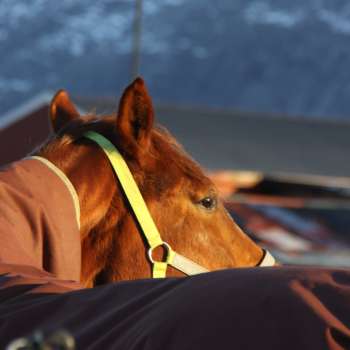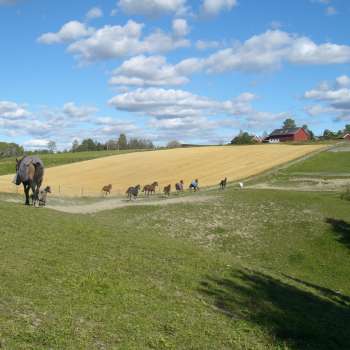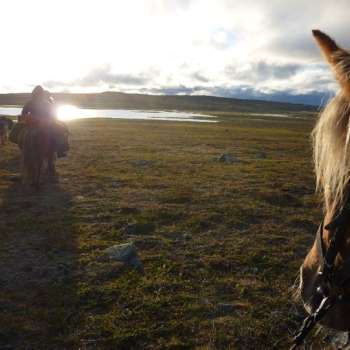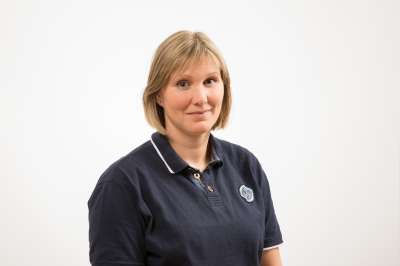
Hest som næring og hobby
Hest som næring og hobby har fått en stadig økende betydning i Norge de siste tiårene. Denne økningen medfører nye områder for bruk av hest og dermed også behov for ny kunnskap. NIBIO har tatt tak i dette behovet og ønsker å bidra til videre vekst basert på forskning og kunnskapsformidling.
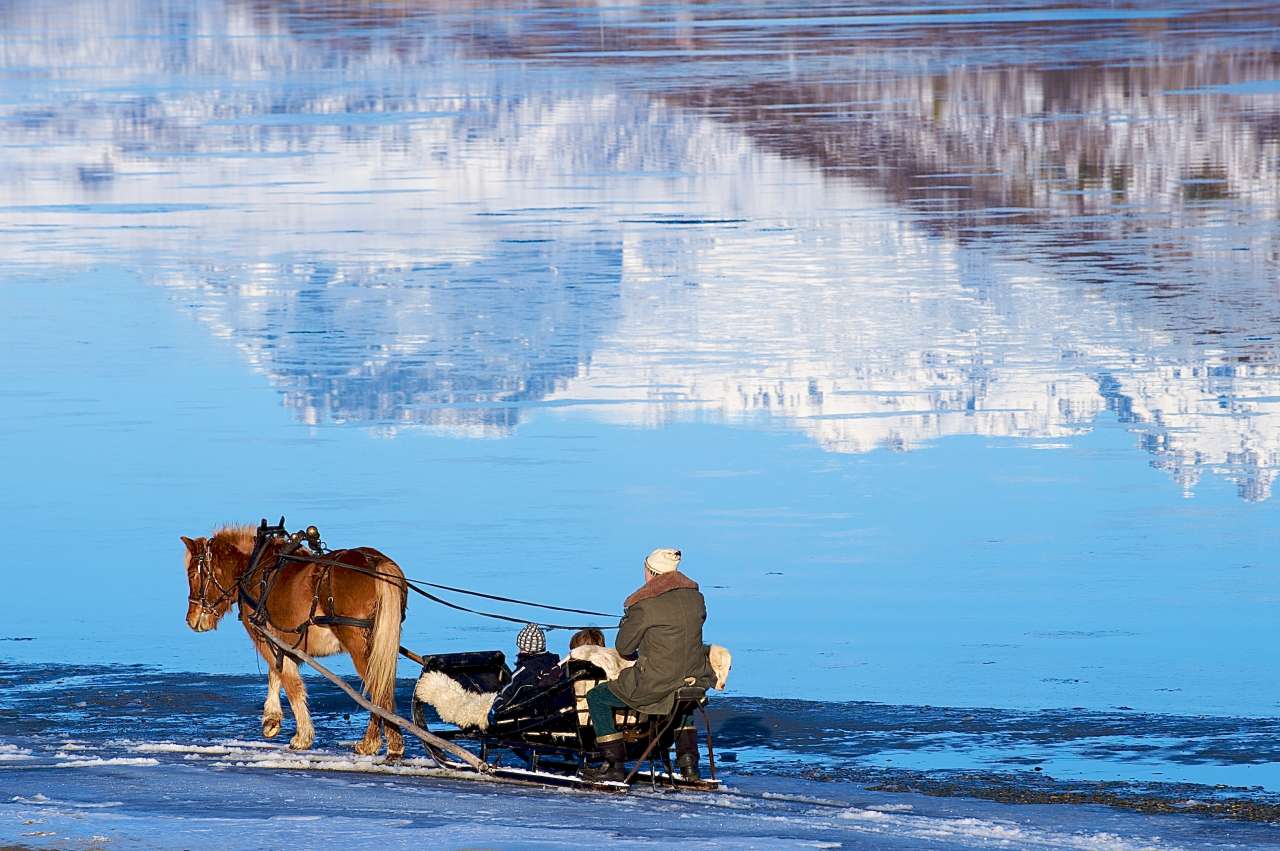
Publikasjoner
Sammendrag
Many horse stables have mechanical-fan ventilation systems but still try to regulate ventilation manually by closing doors and windows on a cold winter night. The aim of this study was to investigate the variation in air quality in Norwegian horse stables with different ventilation systems on days with low outdoor air temperatures. A total of 19 insulated, mechanically ventilated stables with horses kept inside during the night were included in the study. Almost all fans were operated during the night (n=18), but inlets for fresh air were highly variable in design and management leading to potential for ineffectiveness of ventilation functions. In four of the stables, there were no specific air inlet systems, and in five stables, the exit door was used as the only air inlet. The air exchange rate was sufficient in all the stables with an automated temperature thermostat for ventilation control. Mean level of carbon dioxide (CO2) was 1,800 ppm and in one stable CO2 exceeded 3,000 ppm. Mean inside ammonia (NH3) was 1.3 ppm, and only in one stable the level of NH3 exceeded 5 ppm. The total dust concentration was 0.69 ± 0.19 mg/m3, and in two stables, the dust concentration exceeded 1.0 mg/m3. Total and respirable dust levels were higher in stables with ventilation rate below recommended level. Half of the stables visited had a lower calculated air exchanges rate than recommended, and the majority of the stables regulated the ventilation manually by closing doors and inlets during night. This indicates a general lack of knowledge among the stable managers of climatic demand in horses and how to operate mechanical ventilation. Still, the majority of the stables maintained acceptable air quality, with NH3 and dust levels within recommended levels, although most stables had elevated humidity.
Forfattere
Elke Hartmann Knut Egil Bøe Grete H. M. Jørgensen Cecilie Marie Mejdell Kristina DahlbornSammendrag
Limited information is available on the extent to which blankets are used on horses and the owners’ reasoning behind clipping the horse’s coat. Research on the effects of those practices on horse welfare is scarce but results indicate that blanketing and clipping may not be necessary from the horse’s perspective and can interfere with the horse’s thermoregulatory capacities. Therefore, this survey collected robust, quantitative data on the housing routines and management of horses with focus on blanketing and clipping practices as reported by members of the Swedish and Norwegian equestrian community. Horse owners were approached via an online survey, which was distributed to equestrian organizations and social media. Data from 4,122 Swedish and 2,075 Norwegian respondents were collected, of which 91 and 84% of respondents, respectively, reported using blankets on horses during turnout. Almost all respondents owning warmblood riding horses used blankets outdoors (97% in Sweden and 96% in Norway) whereas owners with Icelandic horses and coldblood riding horses used blankets significantly less (P < 0.05). Blankets were mainly used during rainy, cold, or windy weather conditions and in ambient temperatures of 10°C and below. The horse’s coat was clipped by 67% of respondents in Sweden and 35% of Norwegian respondents whereby owners with warmblood horses and horses primarily used for dressage and competition reported clipping the coat most frequently. In contrast to scientific results indicating that recovery time after exercise increases with blankets and that clipped horses have a greater heat loss capacity, only around 50% of respondents agreed to these statements. This indicates that evidence-based information on all aspects of blanketing and clipping has not yet been widely distributed in practice. More research is encouraged, specifically looking at the effect of blankets on sweaty horses being turned out after intense physical exercise and the effect of blankets on social interactions such as mutual grooming. Future efforts should be tailored to disseminate knowledge more efficiently, which can ultimately stimulate thoughtful decision-making by horse owners concerning the use of blankets and clipping the horse’s coat.
Forfattere
L.J. Keeling Knut Egil Bøe J.W. Christensen S. Hyyppä H. Jansson Grete H. M. Jørgensen J. Ladewig Cecilie Marie Mejdell S. Särkijärvi E. Søndergaard E. HartmannSammendrag
There is increasing interest in keeping horses in groups, but progress is hampered by a lack of knowledge about which horses can and should be kept together. Therefore, our objective was to investigate the effect of group composition on the occurrence of injuries among horses, the ease of removing horses from groups and horses’ reactivity to a fearful stimulus. Using a matched case control design, 61 groups of horses were studied in Denmark, Norway, Finland and Sweden. They were allocated into groups of similar or different age and sex or where membership changed regularly or remained stable. Injuries were recorded before mixing the horses into treatment groups, the day after mixing and four weeks later. Reactivity of horses to a moving novel object and the behaviour of a horse being removed from its group and the reactions of other group members towards this horse and the handler were evaluated. It was hypothesized that a more socially variable group composition has beneficial effects on behaviour, ease of handling and reducing reactivity whereas frequent changes in group composition has negative consequences, resulting in more injuries. We found that differences in treatment effects were mainly related to breed, rather than group composition. Icelandic horses reacted less to the movement of the novel object (P = 0.007) and approached it more afterwards (P = 0.04). They also had fewer new injuries than warmbloods following mixing (P < 0.001) and fewer than all other groups four weeks later (P < 0.01). Most new injuries after mixing were minor and recorded on the horse’s head, chest, hind legs and rump. In conclusion, variations in sex and age composition of the group had little effect on injury level, reactivity and ease of handling compared to the general effect of breed. Concerns about the risk of severe injuries associated with keeping horses in groups are probably overestimated. Thus, we propose that horses can be successfully kept in groups of different sex and age composition.
Sammendrag
This paper describes a method in which horses learn to communicate by touching different neutral visual symbols, in order to tell the handler whether they want to have a blanket on or not. Horses were trained for 10–15 min per day, following a training program comprising ten steps in a strategic order. Reward based operant conditioning was used to teach horses to approach and touch a board, and to understand the meaning of three different symbols. Heat and cold challenges were performed to help learning and to check level of understanding. At certain stages, a learning criterion of correct responses for 8–14 successive trials had to be achieved before proceeding. After introducing the free choice situation, on average at training day 11, the horse could choose between a “no change” symbol and the symbol for either “blanket on” or “blanket off” depending on whether the horse already wore a blanket or not. A cut off point for performance or non-performance was set to day 14, and 23/23 horses successfully learned the task within this limit. Horses of warm-blood type needed fewer training days to reach criterion than cold-bloods (P < 0.05). Horses were then tested under differing weather conditions. Results show that choices made, i.e. the symbol touched, was not random but dependent on weather. Horses chose to stay without a blanket in nice weather, and they chose to have a blanket on when the weather was wet, windy and cold (χ2 = 36.67, P < 0.005). This indicates that horses both had an understanding of the consequence of their choice on own thermal comfort, and that they successfully had learned to communicate their preference by using the symbols. The method represents a novel tool for studying preferences in horses.
Sammendrag
Reasons for performing study: Horses may adapt to a wide range of temperatures and weather conditions. Owners often interfere with this natural thermoregulation ability by clipping and use of blankets. Objectives: To investigate the effects of different winter weather conditions on shelter seeking behaviour of horses and their preference for additional heat. Study design: Observational study in various environments. Methods: Mature horses (n=22) were given a free choice test between staying outdoors, going into a heated shelter compartment or into a nonheated shelter compartment. Horse location and behaviour was scored using instantaneous sampling every minute for one hour. Each horse was tested once per day and weather factors were continuously recorded by a local weather station. Results: The weather conditions influenced time spent outdoors, ranging from 52 % (of all observations) on days with mild temperatures, wind and rain to 88 % on days with less than 0°C and dry weather. Shivering was only observed during mild temperatures and rain/sleet. Small Warmblood horses were observed to select outdoors less (34 % of all observations) than small Coldblood horses (80 %). We found significant correlations between hair coat sample weight and number of observations outdoors (ρ = 0.23; P = 0.004). Conclusions: Horses selected shelters the most on days with precipitation and horses changed from a nonheated compartment to a heated compartment as weather changed from calm and dry to wet and windy. Horse breed category affected the use of shelter and body condition score and hair coat weight were associated with voluntary shelter selection.
Forfattere
Elke Hartmann Knut Egil Bøe Janne Winther Christensen Seppo Hyyppä H Jansson Grete H. M. Jørgensen Jan Ladewig Cecilie Marie Mejdell Yezica Norling Margareta Rundgren Susanne Särkijärvi Eva Søndergaard Linda J KeelingSammendrag
Keeping horses in groups is widely recommended but limited information is available about how this is implemented in practice. The aim of this survey was to describe how horses are kept in the Nordic countries in relation to sex, age, breed, and equestrian discipline and to assess owners’ attitudes toward keeping horses in groups. Horse owners in Denmark, Finland, Norway, and Sweden were approached using a web-based questionnaire, which was translated into 4 languages and distributed online via equestrian forums, organizations, and social media. The number of respondents was 3,229, taking care of 17,248 horses. Only 8% of horses were never kept in groups, 47% were permanently grouped for 24 h/d, and 45% were stabled singly but grouped during turnout. Yearlings were most often permanently kept in groups (75%), mares and geldings more commonly during parts of the day (50 and 51%, respectively), and stallions were often kept alone (38%). Icelandic horses were more likely to be permanently kept in groups (36%) than warmbloods (16%) and ponies (15%). Twice as many competition horses (51%) were never grouped compared with horses used for breeding (20%) or leisure purposes (15%). The majority of respondents (86%) strongly agreed that group housing benefits horse welfare and that it is important for horses to have the company of conspecifics (92%). Nevertheless, not all horses were kept in groups, showing that attitudes toward group housing may not necessarily reflect current management. The risk of injury was a concern of many respondents (45%), as was introducing unfamiliar horses into already established groups (40%) and challenges in relation to feeding in groups (44%). Safety of people (23%) and difficulties handling groupkept horses (19%) were regarded as less problematic. Results suggest that the majority of horses have the possibility to freely interact with other horses, either as fulltime members of a group during 24 h/d or during turnout. Future research should address the extent to which being a part-time member of a group affects horse welfare. For permanent group housing to become more widespread, such as it is the case for most farm animals, future research could focus on solving some of the reoccurring problems perceived with keeping horses in groups. The dissemination of evidence-based information on all aspects around keeping horses in groups can ultimately stimulate further positive changes in the management of group-kept horses.
Sammendrag
Våren 2014 ble det utarbeidet en spørreundersøkelse til norske hesteeiere som tok for seg spørsmål om oppstalling, luftegårder og beite. Undersøkelsen ble spredt via internett og ble besvart av totalt 2075 personer som drev med hest. Hele 27,5 % oppga at hestene ble holdt i løsdrift/utegang, mens 53,6 % oppga at hestene ble holdt i isolert stall og 16,5 % oppga uisolert stall. Majoriteten av hestene (53,1 %) som ble holdt i tradisjonelle staller var i luftegård 5 – 10 timer pr. dag og 35,0 % var i luftegård > 10 timer pr. dag. På vinterstid ble 35,3 % hestene som stod i tradisjonell stall eller utebokser holdt i luftegårder som var < 300 m2. Blant hestene som stod i tradisjonell stall eller utebokser var det 23,0 % som ble holdt enkeltvis i luftegårdene, mens de resterende ble holdt to eller flere sammen. 84,0 % av respondentene svarte at hesten gikk på beite hele døgnet en periode på sommeren. Undersøkelsen tyder på at hester av kaldblodstype tilbringer mye tid ute og oftest i gruppe, mens spranghester opplever størst restriksjoner på atferdsmessige behov, med minst beitebruk, kortest tid i luftegård og minst gruppehold.
Forfattere
Cecilie Marie Mejdell Grete H. M. Jørgensen Linda J Keeling Janne Winther Christensen Knut Egil BøeSammendrag
Group housing of horses is not very widespread, despite obvious advantages for their development and mental well-being. One often expressed rationale for this is that horse owners are worried about the risk of injuries due to kicks, bites or being chased into obstacles. To address this concern, we developed and validated a scoring system for external injuries in horses to be able to record the severity of a lesion in a standardized and simple way under field conditions. The scoring system has five categories from insignificant loss of hair to severe, life threatening injuries. It was used to categorize 1124 injuries in 478 horses. Most of these horses were allocated to groups to study the effect of group composition (i.e. same age or mixed, same gender or mixed, socially stable or unstable groups) on behaviour and injuries. The material included mainly riding and leisure purpose horses of different breeds, age and gender. Most injuries occurred the day after mixing. Injuries of the more severe categories 4 and 5, which normally would necessitate veterinary care and/or loss of function for some time, were not observed at all. The vast majority of the recorded injuries were category 1 lesions (hair loss only). A few such injuries were found on most horses, some horses had none, and a few had many. The second most common injury type was category two (abration/scrape into, but not through the skin, and/or a moderate bruise/contusion). Category 3 injuries (a minor laceration and/or contusion with obvious swelling) were only recorded in a baseline subset of 100 riding horses, there comprising 4% of the injuries. Whereas most of the injuries were found on the body, the category 3 injuries were mainly found on the limbs and head. The reason for this is probably that the skin there is tight and thus is more easily lacerated. Icelandic horses tended to have fewer and less severe injuries compared to other breeds. There was also a breed effect on location of the injuries. We conclude that the risk for serious injuries when horses are kept in groups is generally low and fear of injuries should not be a reason to prevent horses from social interaction with other horses. However, we emphasize that most of the recordings were performed during the summer period, and many horses were unshod. The situation might have been different in winter, and special caution should be taken if mixing horses shod with ice studs.
Sammendrag
Mange hesteeiere bruker dekken på sine hester under ulike forhold, både når de er ute, når de står inne, når de ris og under transport, men det finnes ingen oversikt over hvor stort omfanget av dekkenbruk er og hvilke oppfatninger hesteeierne har om bruk av dekken. Innlegg på nettsider, i blogger og i ulike hestetidsskrifter tyder på at hesteeiere har veldig klare, men likevel svært forskjellige oppfatninger om dekkenbruk. Hensikten med denne spørreundersøkelsen var å kartlegge bruk av dekken til hest i Norgeunder ulike vær- og oppstallingsforhold og for ulike hesteraser. Våren 2014 ble det utarbeidet en spørreundersøkelse med til sammen 41 spørsmål til hesteeiere og andre med ansvar for stell av hest om bruk av dekken. Spørsmål og aktuelle svaralternativer ble lagt inn i programmet Quest-back. Spørreundersøkelsen ble publisert på nettstedet til Norsk hestesenter, Norsk Rytterforbund, Norsk Travselskap og nettsiden www.hest.no, samt på nettsidene til NMBU, Veterinærinstituttet (VI) og Bioforsk og også spredt via Facebook. Undersøkelsen ble besvart av totalt 2075 personer som drev med hest. Majoriteten av hesteeierne (55,1 %) var i aldersgruppen 20 – 39 år og 95,6 % av hesteeierne var kvinner. Varmblods ridehest utgjorde den største gruppen (25,1 %) og deretter kom kaldblods ridehest (19,1 %) og Islandshest (14,6 %), men både varmblods og kaldblods travere, engelsk fullblods, arabisk fullblods, frieser og ulike ponnier var representert i materialet. 53,6 % av de 2075 hesteeierne oppga at hestene ble holdt i en isolert stall (med/uten varme) om vinteren, mens 16,5 % oppga at hestene var i en uisolert stall og 25,3 % at hestene gikk i et løsdriftssystem med tilgang til leskur. 83,7 % av de 2075 hesteeierne oppga at de brukte dekken på hestene under gitte forhold når de var ute, mens 16,3 % oppga at de aldri brukte dekken. De viktigste årsakene til at hesteeierne brukte dekken var lave temperaturer, nedbør og vind samt når hesten var svett etter bruk. Det var spesielt ved utetemperaturer under + 10 °C at det ble benyttet dekken på hester som gikk ute. 35,2 % oppga at hesten ble klippet. Nesten 95 % av hesteeierne som hadde varmblods ponnier eller varmblods ride- og kjørehester, oppga at de brukte dekken når hesten var ute. Bare 65,8 % av hesteeiere med kaldblods ponnier oppga at de brukte dekken når hesten var ute, mens tilsvarende tall for hesteeiere med kaldblods ride- og kjørehester var 78,8 %. 59,1 % av eierne bruker dekken på hesten når den står inne. For hester som var oppstallet i isolert stall om vinteren, svarte 92,5 % av hesteeierne at de benyttet dekken på hesten når den var ute, mens tilsvarende tall for hester oppstallet i uisolert stall eller uteboks var 86,9 % og 64,0 % i løsdriftssystemer med utegang. Blant de hesteeierne som klippet hesten sin var det 97,8 % som brukte dekken under noen forhold når hesten var ute, mens tilsvarende tall for de hesteeierne som ikke klippet hesten var 76,0 %.
Sammendrag
Det er ikke registrert sammendrag
Sammendrag
Artikkel på norsk på stallmestern.no: Den 6. og 7. juni 2011 ble det i Reykjavik på Island avholdt et seminar om oppstalling og hold av hest. Seminaret samlet rundt 50 forskere, rådgivere, bygningskonsulenter og hesteeiere fra syv land og ble arrangert av NJF, den nordiske organisasjonen for jordbruksforskere. Dette er et sammendrag av de viktigste forskningsresultatene og diskusjonene som kom fram i løpet av seminaret.

